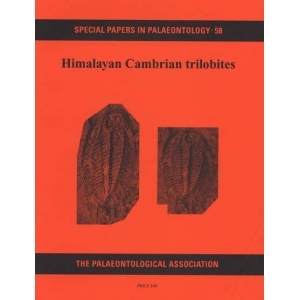
Special papers in Palaeontology: 58
<br />1997
<br />
<br />Himalayan Cambrian trilobites.
<br />P A Jell and N C Hughes.
<br />
<br />113 pp., 32 plates, 10 text-figs, 3 tabs.
<br />
<br />ABSTRACT. In the Himalaya of northern India and Pakistan, Cambrian trilobites are widespread and provide data to assess palaeogeography and to constrain tectonic models of Himalayan evolution. Collections from Kashmir, Spiti and the Salt Range, described early this century are revised taxonomically and recent collections from these areas and from the Zanskar Valley, Ladakh and the Krol-Tal Belt of the Lesser Himalaya are described. Cambrian sequences of these areas are correlated biostratigraphically with each other and with China. Himalayan Cambrian trilobites range in age from Tsanglangpuian to Kushanian. Previous suggestions that these faunas show marked provinciality within the region are rejected; they have strong generic and specific level affinities with faunas from China (particularly south-western China), Kazakhstan and Australia and cosmopolitan elements are known from several other parts of the world. The trilobite faunas do not suggest major environmental or structural separation between Himalayan basins during the Cambrian. Deposits in the Krol- Tal Belt contain only redlichiid trilobites of Early Cambrian (Tsanglangpuian) age. In the Salt Range, in the Pohru and Liddar Valleys, Kashmir and in Spiti, trilobite-bearing formations of this age are overlain by early Mid Cambrian strata. Late Mid Cambrian trilobites occur in Kashmir and the Zanskar Valley in Ladakh, but only in Kashmir are basal Late Cambrian sedimentary rocks confirmed. One new genus, Shahaspis, and three new species, Xela mathurjoshi, Damesops sheridanorum and Eoshengia? sudani are erected.